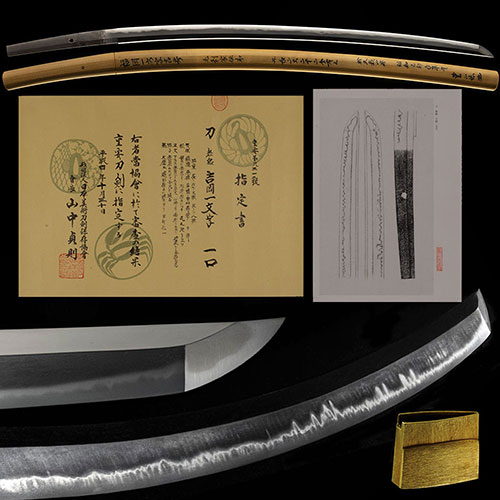
吉岡一文字 刀 Yoshioka Ichimonji Katana
No.567176刀 吉岡一文字 毛利家伝来 薫山鞘書 丁子華やかに乱れる傑作 二尺二寸二分Katana Yoshioka Ichimonji inherited from the Mori family, Kunzan scabbard, a masterpiece with gorgeous Chouji Midare, 67.3cm
ご成約Sold
- 極めKiwame
- 吉岡一文字Yoshioka Ichimonji
- 時代Period
- 鎌倉時代Kamakura period
- 法量Size
-
刃長 67.3cm (二尺二寸二分) 反り 1.7cm
元幅 2.8cm 先幅 1.9cm 元重 0.59cm 鎬厚 0.64cm 先重 0.43cm 鋒長 3.0cm 茎長 19.9cm 重量 687gHachou 67.3cm (二尺二寸二分) Sori 1.7cm
Moto-Haba 2.8cm Saki-Haba 1.9cm Moto-Kasane 0.59cm Shinogi-Thikess 0.64cm Saki-Kasane 0.43cm Kissaki-Chou 3.0cm Nakago-Chou 19.9cm Weight 687g - 国Country
- 備前Bizen
- 姿Shape
- 鎬造、庵棟、身幅尋常、反りやや深く、腰反りつき、中鋒。Shinogidukuri, Iorimune, Standard Mihaba, Slightly deep Sori, Koshizori-tsuki, Chu-Kissaki.
- 鍛Kitae
- 板目肌に、杢目・流れ肌交じり、地沸微塵に厚くつき、乱れ映り鮮明に立つ。Itamehada, Mokume and mixed Nagarehada, Jinie entered fine and thickly, Vividly Midare-Utsuritatsu.
- 刃文Hamon
- のたれて、互の目に、丁子刃・小互の目・蛙子調の丁子・飛び焼きなど交じり、足よく入り、匂出来、小沸よくつき、金筋・砂流し細かく頻りにかかり、匂口明るい。のたれて、互の目に、丁子刃・小互の目・蛙子調の丁子・飛び焼きなど交じり、足よく入り、匂出来、小沸よくつき、金筋・砂流し細かく頻りにかかり、匂口明るい。Notare, Gnome, Choujiba, Small-Gunome, Kawazuko-stpyle Chouji, Mixed Tobiyaki, Ashi entered well, Nioi-deki, Small-Nie-tsuki, Kinsuji and Sunagashi entered finely well, Nioikuchi is bright. Notarete, Gunome, Choujiba, Small-Gunome, Kawazuko-style Chouji, Mixed Tobiyaki, Ashi entered well, Nioi-deki, Small-Nie entered well, Kinsuji and Sunagashi entered finely well, Nioikuchi is bright. Nioikuchi is bright.
- 帽子Boushi
- のたれごころに焼詰風。Notaregokoro-Yakitsume-style
- 茎Nakago
- 茎は、大磨上、先切、鑢目勝手下り、目釘孔一。Nakago is Oh-suriage, Sakikiri, Yasurime-kattesagari, Mekugiana is one.
- ハバキHabaki
- 金着二重。Double gold.
- 説明Drscription
- 鎌倉時代の備前物は、一文字と長船の両派に代表され、一文字派は以後南北長期にかけて福岡・吉岡・岩戸などの地に繁栄し、多くの良工が輩出した。この派が一文字と呼称される所以は、茎に「一」の字をきることに因るが、銘は「一」の字のみのものと、他に「一」の字の下にさらに個銘を加えるもの、また個銘だけのものもある。吉岡一文字派は、福岡一文字派に次いで鎌倉時代末期から南北長期にかけて繁栄した。一派の代表工には助光・助吉・助茂・助次・助義などがいて「助」を通字としており、作風は、乱れの中に互の目が目立ってやや小出来となるものである。この刀は、元は二尺八寸程の太刀で、腰反りつき、中鋒詰まりごころとなる鎌倉中期の体配で、見事な乱れ映りが鮮やかに立つ地鉄に、飛び焼き・蛙子調の丁子など交え華やかに乱れながら、金筋・砂流し頻りに入るなど刃中の働き豊かな傑作である。体配からも時代は上がり本間先生極めの吉房あたりと思われる毛利家伝来の名品である。Bizen-mono in the Kamakura period was represented by both the Ichimonji and Osafune schools, and the Ichimonji-ha prospered in Fukuoka, Yoshioka, Iwato, and other areas until the Nanbokucho period, producing many excellent craftsmen. The reason why this school is called Ichimonji is because the character "ichi" is cut on the stem. There are some that add an inscription, and some that only have an individual inscription. The Yoshioka Ichimonji school flourished in the latter half of the Kamakura period, following the Fukuoka Ichimonji school. Sukemitsu, Sukeyoshi, Sukemo, Suketsugu, Sukeyoshi, etc. are the representative craftsmen of the school, and they use 'suke' as a common character. This sword was originally a Tachi about 67.3cm, with Koshizori-tsuki, and Chu-Kissaki-tsumarigokoro designed from the mid-Kamakura period, It is a masterpiece with a rich effect on the blade, with vividly Midare-Utsuritatsu Jitetsu, Tobiyaki, Kawazuko-style-Chouji, Gorgeouse Midare, Kinsuji and Sunagashi entered well. Judging from its appearance, it is old and is a masterpiece passed down from the Mori family, which is thought to have been made by Yoshifusa, the master of professor Honma.


